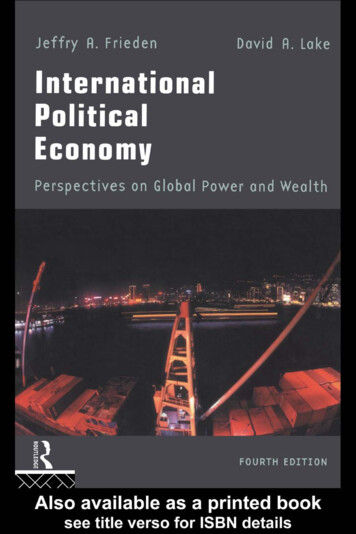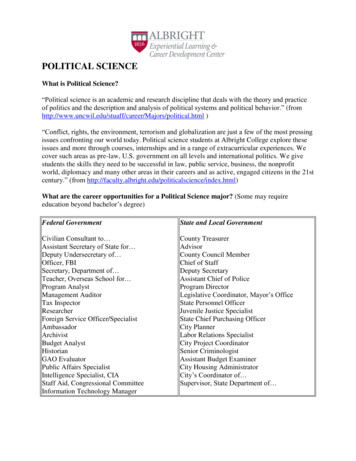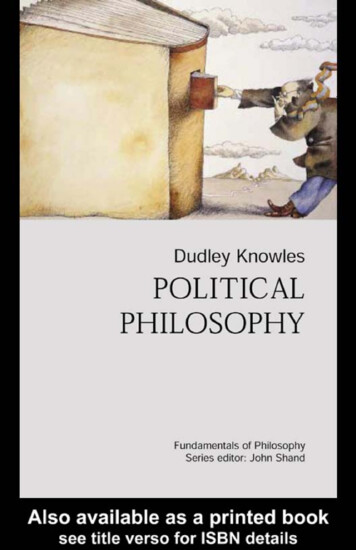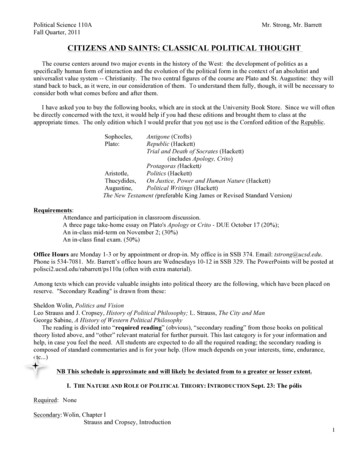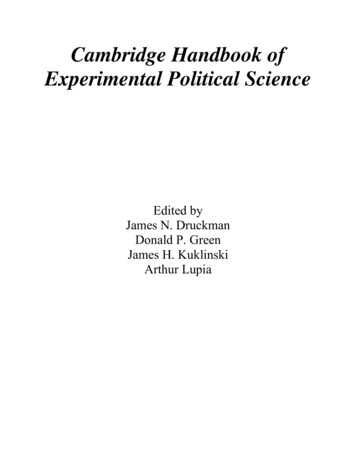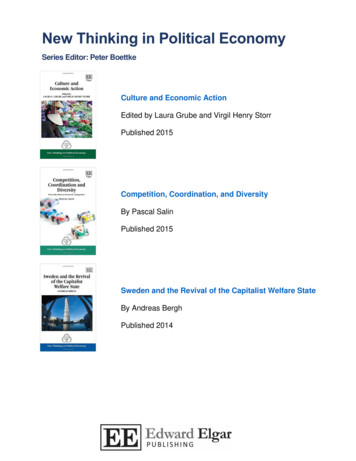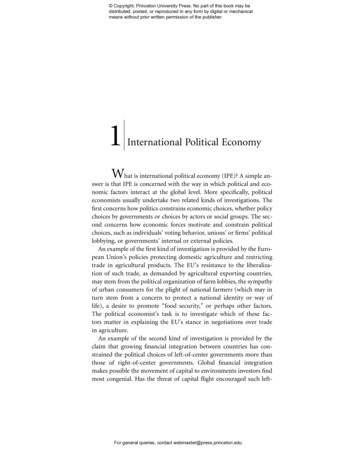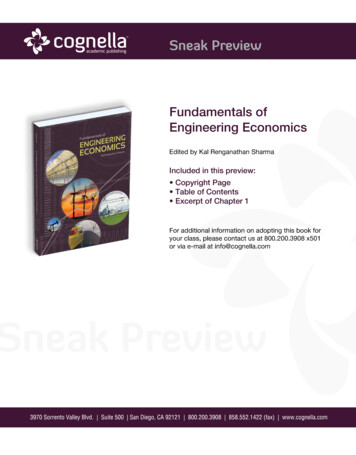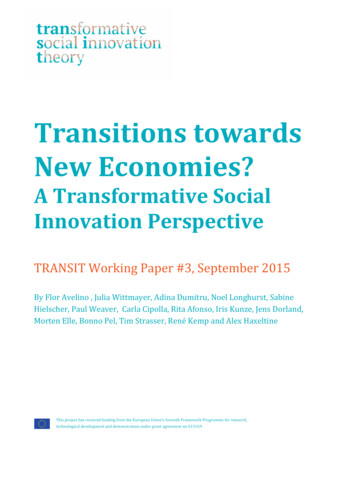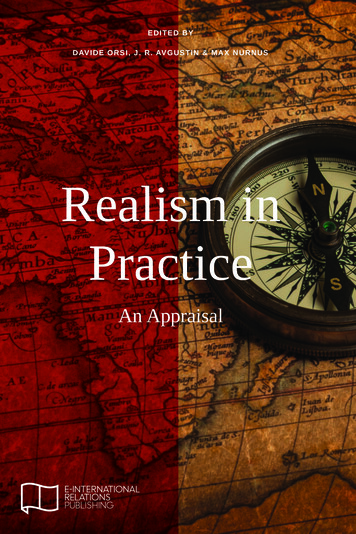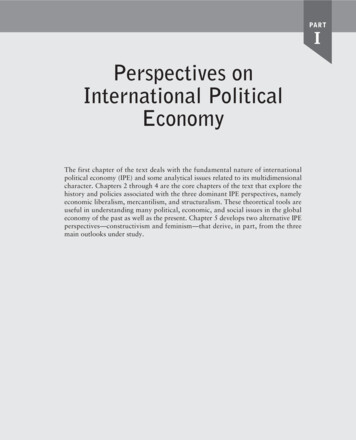
Transcription
PartIPerspectives onInternational PoliticalEconomyThe first chapter of the text deals with the fundamental nature of internationalpolitical economy (IPE) and some analytical issues related to its multidimensionalcharacter. Chapters 2 through 4 are the core chapters of the text that explore thehistory and policies associated with the three dominant IPE perspectives, namelyeconomic liberalism, mercantilism, and structuralism. These theoretical tools areuseful in understanding many political, economic, and social issues in the globaleconomy of the past as well as the present. Chapter 5 develops two alternative IPEperspectives—constructivism and feminism—that derive, in part, from the threemain outlooks under study.
Chapter1What Is InternationalPolitical Economy?We Are the 99%: A Haitian hillside.Georgina AllenWhen a philosopher has once laid hold of a favorite principle, which perhaps accountsfor many natural effects, he extends the same principle over the whole creation, and reduces to it every phenomenon, though by the most violent and absurd reasoning. Ourown mind being narrow and contracted, we cannot extend our conception to the varietyand extent of nature . . .David Hume, “The Sceptic”2
The Darkness on the Edge of TownThe Darkness on the Edge of TownWhat are the chances you will find a good paying job—or any job for that matter—when you graduate from college in the next few years? Have your parentsor people you know lost their jobs, the family home, or a big chunk of their retirement savings? How are you adjusting to the financial crisis? Maybe things haven’tbeen that bad for you, yet! Reading the headlines of any major newspaper, youmight sometimes worry that the world is on the brink of a global economic catastrophe, if not a second Great Depression. The effects of the global economic crisishave made many people feel tense, fearful, and depressed.The collapse of the U.S. housing market in 2007 morphed into a credit crisisthat threatened some of the biggest banks and financial institutions in theUnited States and Europe. Government leaders responded with a variety of bank rescuemeasures and so-called stimulus packages to restart their economies. These interventions angered many ordinary folks who felt that the bailouts rewarded bankersand CEOs who had caused the crisis in the first place. Meanwhile, many peoplearound the world were forced out of their homes and became unemployed. Theysuffered cuts in social services, health care benefits, and education spending whengovernments were forced to trim budgets.As we write in late 2012, the hoped-for recovery has proved elusive. Unemployment in the United States is stuck at 7.9 percent; in the European Union (EU), it hasrisen to 11.6 percent (23.4 percent for young people). Home foreclosures and stagnant incomes continue to place enormous strain on many families’ finances. TheEU has fallen into another recession, with countries like Greece, Italy, Spain, andPortugal so deep in debt that they might slide into national bankruptcy, causing theEU’s monetary system to collapse. People seem to have lost confidence in nationaland international political institutions that underpin capitalism and democracy. Isthis what the Great Transformation from industrial to post-industrial society wassupposed to look like? Are globalization and the so-called “creative destruction”of new technologies shrinking the middle classes in Western countries and permanently shifting economic dynamism to Asia and Latin America?Adding to the sense of gloom are events around the world in the last few years.High oil prices have benefitted giant oil companies while hurting consumers. The giant British Petroleum (BP) oil spill precipitated an environmental catastrophe in theGulf of Mexico. Japan’s Fukushima earthquake and tsunami damaged several nuclearpower plants, causing release of dangerous radioactive material across a large swath of territory. High agriculture commodity prices have raised the cost of food and increasedlevels of world hunger. Because there has been little progress in reducing reliance onfossil fuels, capping carbon emissions, or investing in alternative energy resources, thethreat of catastrophic climate change looms larger. And wars in Syria, Afghanistan,Somalia, and the Congo are destroying the livelihoods of millions of people.Hope on the Horizon?Is there only gloom and doom around the globe? Surely, no! As we discuss inChapter 13, emerging powers such as China, India, Brazil, and Russia have dramatically reduced poverty in the last fifteen years and made it possible for hundreds3
4C h a p te r 1What Is International Political Economy?of millions of people to join the middle class. Fortunately, they continued to growat a fairly robust pace after 2007; more jobs, investment, and consumption inthese countries helped keep the rest of the world from falling into a deeper recession. For most of the last decade, sub-Saharan Africa has also grown surprisingly fast, thanks in part to high prices for oil and commodities exports. And the European Union won the 2012 Nobel Peace Prize, a reminder that—despite itsserious economic and social problems today—the community has advanced thecauses of “peace and reconciliation, democracy, and human rights” for more thansixty years.Along with these rays of hope are three interrelated global developments thatmerit discussion at the beginning of this textbook because they are profoundlyshaping the international political economy: the Arab Spring, the European sovereign debt crisis, and the Occupy Wall Street (OWS) movement. Taking place on threedifferent continents since 2011, they have shaken political institutions and spurredwaves of political protests in response to a variety of social and economic ills.None of us knows how these momentous developments will play out, but we canbe sure that they will affect our daily lives and pocketbooks for many years. Eachis a double-edged sword: a potential harbinger of positive change and a potentialforeshadowing of worse yet to come. In other words, each development can eitherhelp lead to a more stable, prosperous world in which human security is betterguaranteed or render divisions within and between societies wider than before sothat cooperative relations and a fairer distribution of resources remain ever moreelusive goals.The Arab Spring took the world by surprise—a reminder that social scientists still do not have good tools to predict when and why large-scale changeswill occur in complex socio-political systems. On December 17, 2010, a Tunisianstreet vendor named Mohamed Bouazizi set himself on fire in reaction to harassment by police officers. His death sparked street demonstrations that broughtdown the Tunisian government one month later. Protests spread like wildfiresto other countries in the Middle East and North Africa. After eighteen days ofmass demonstrations, Egypt’s authoritarian president Hosni Mubarak resignedon February 11, 2011, replaced by a military council. On February 15, residentsof Benghazi, Libya, rose up against the regime of Muammar Qaddafi. Followingmonths of NATO bombing and rebel fighting, Qaddafi was killed on October 20,2011, and a National Transitional Council took power. The dramatic politicalprotests—which captivated television viewers and Twitter-feed followers aroundthe world—created an opportunity for a number of Arab countries to join thecommunity of democratic nations. Yet the crackdown in Syria showed the worldhow determined some authoritarian leaders in the Middle East are to remain inpower—even at the expense of killing tens of thousands of their own citizens.With the genie of Arab political opposition out of the bottle, countries in the Middle East and North Africa are rapidly changing. Fortunately, high oil pricesand a return to relative stability in many places could improve conditions in 2013.Along with the Arab Spring came President Barack Obama’s withdrawal ofall U.S. troops from Iraq at the end of 2011. An ignominious end to an imperial endeavor, the withdrawal seemed to signal that the U.S. public was no longerwilling to pay for wars that drain the public treasury. President Obama refocused
The Darkness on the Edge of TownU.S. policy on fighting against the Taliban in Afghanistan and ratcheting up pressure on Iran to abandon its effort to develop nuclear weapons. Many analystsbelieve that Obama’s decisions reveal a significant weakening of U.S. influence inthe Middle East. Perhaps to counteract this decline, Obama decided to bolster theAmerican military presence in the Pacific by cultivating ties with countries afraidof China’s rise and stationing 2,500 troops permanently in northern Australia beginning in November 2011.A second development—the European sovereign debt crisis—relentlessly gathered steam after 2010 in the face of a prolonged recession that made it hard for somecountries to pay back huge loans to domestic and foreign banks. European Unionleaders had hoped to contain the debt problems in Greece and Ireland, but governments in Spain and Portugal also began to have trouble raising new money by issuing new government bonds. All four countries in 2012 had to get financial bailoutsin exchange for adopting painful government spending cuts that contributed to highunemployment. Even with help from the European Central Bank, these countrieshave dire conditions that threaten the stability of the European financial system.Europe’s responses to its debt crisis have stimulated widespread social unrest.Severe austerity measures have spawned street protests throughout the continentand brought changes of government in Greece, Italy, and Spain. Some EU leadersand analysts believe that the crisis will spur European countries to form closer ties,while others foresee the death of the euro and the prospect of national bankruptcies as some countries refuse to pay back onerous loans. If problems worsen inFrance and Italy, the EU could unravel economically, causing another deep globalrecession. The crisis is forcing Germany to decide if it is willing to share the costsof making the EU stronger, or if it will pursue its purely national interests. Theoutcomes will likely cause changes in Europe’s traditionally generous social programs and in Europe’s influence in the world.A third development started as an anti-Wall Street protest in New York City’sZuccotti Park on September 17, 2011. Two weeks later, the Occupy Wall Streetmovement had quickly spread to many major U.S. cities, with encampments and“general assemblies” in public spaces. Similar “occupations” occurred in Europe,Israel, Chile, and Australia. Although the majority of participants in the OWSsocial movement have been students, union workers, progressive activists, and theunemployed, their ideas seemed to resonate with a significant number of the middle class. Calling themselves the “99%” (in contrast to the wealthiest 1 percent ofAmericans), OWS protestors criticized financial institutions, condemned WallStreet greed, and called for a reduction of corporate control over the democratic process. Although OWS encampments disappeared, the movement tookup new campaigns in 2012, including efforts to stop home foreclosures andreduce student debt.What do these three developments have in common? While each has its owncauses, the protestors collectively represent a reaction to corrupt government andgrowing inequality. In three large regions—the Middle East, Europe, and NorthAmerica—movements sought protection from financial and cultural globalizationthat left people feeling at the mercy of market forces. In many cases, protestors feltthat they were unfairly forced to bail out the wealthy but denied a chance to sharemany of the benefits of previous growth. Austerity policies that many governments5
6C h a p te r 1What Is International Political Economy?had adopted since 2008—and even earlier in the Arab countries—cut into a hostof public social programs such as education and relief for the poor. Many disgruntled citizens disagreed with their leaders, who argued that such reductions werenecessary to reduce the size of government, balance national budgets, and stimulate economic recovery.While Arabs claimed a political voice that had been squashed by decades ofdictatorial rule, Americans and Europeans seemed to demand a new kind of politics freed from the grip of special interests and big money. In all three cases, eliteswho were supposed to be the experts on political and financial affairs suddenlywere at a loss to explain why things had gotten so bad under their watch. Witha loss of faith in Arab regimes, EU leaders, and U.S. bankers came a certain“ denaturalization” of ruling ideologies such as economic liberalism. A new emphasis was placed on democratic participation and economic fairness.Despite a new zeitgeist in the air in three continents, old political and economic institutions were still resilient. Many regimes held firm in the MiddleEast. American banks grew even bigger after government bailouts, and moremoney than ever poured into the campaign war chests of Democratic and Republican political candidates. EU political elites continued to make deals thatseemed designed to save big investors and banks rather than ordinary citizens.The alternatives to the old did not always promise a better future, either. In theaftermath of the Arab Spring, Islamists like Egypt’s new president MohamedMorsi made their own undemocratic power grabs, seeking to impose religiouslyconservative policies and weaken women’s rights. Reactions against austerity in Europe strengthened extreme right-wing parties in Greece and Francewhile fueling anti-EU or secessionist sentiments in the United Kingdom and C atalonia. And by refusing to organize and engage in “normal” politics, theOWS forces dissipated—leaving normal two-party gridlock in Washington afterthe November 2012 elections.The Road AheadBy discussing above the three big developments, as well as the problems and promises in the global economy, we have hopefully given you a sense of some of theimportant phenomena we seek to understand in international political economy.Not unsurprisingly, there are fierce debates about the causes of current crises andthe best solutions to them. One of the arguments we make in this text is that toadequately describe and explain the current global financial crisis—or any of theother issues covered in the different chapters—we must use an analytical approachthat synthesizes methods and insights derived from economics, political science,and sociology as conditioned by an understanding of history and philosophy. Asyou delve deeper into the material, you will learn a variety of theories and analytical tools that help us interpret the interrelationships of the state, market, andsociety in different nations.The IPE method bridges different academic disciplines to better explain complex, real-world problems that span physical and intellectual boundaries. Whilethis statement might sound a bit formal and confusing at this point, keep in mindthat we do not think you need to be an economics major, a specialist in finance,
The What, Why, and How of International Political Economyor a Middle East expert to understand the basic parameters of the global financialcrisis or the Arab Spring. This book is written for students who have limited background in political science, economics, or sociology, as well as for those who wantto review an assortment of topics in preparation for graduate school.In the next section, we look at how to study IPE—its three distinct analytical perspectives and a number of methodological issues with which IPE studentsshould become acquainted. All the chapters in the book cover important theoretical and policy issues that have connections to the three developments we havementioned—and to many more. In this way, we hope students might better understand different dimensions of the problems and then make some reasoned judgments about how to solve them.Later in this chapter, we discuss the popular phenomenon of globalization asa way to introduce students to many of the political-economic conditions that ledup to the global financial crisis. Many IPE experts have asserted that the economicliberal ideas behind globalization may have contributed to the crisis. Opinions differ, however, on whether or not the crisis signals the end of laissez-faire economicpolicies, or even the end of capitalism itself.The What, Why, and How of InternationalPolitical EconomyOur discussion of the financial crisis and its consequences makes clear that today’s complex issues can no longer be easily analyzed and understood by usingany single set of disciplinary methods and concepts. Those who study IPE are, in essence, breaking down the analytical and conceptual boundaries between politics,economics, and sociology to produce a unique explanatory framework. Followingare several examples of questions that traditional academic disciplines might askas they seek to explain the global financial crisis. Each discipline focuses on different actors and interests: International Relations: How much has the financial crisis detracted fromthe ability of states to pay for military defense? How has the crisis affectedthe conditions of war or terrorism in poor states? As Europe, Japan, and theUnited States struggle, will emerging countries like China, India, and Brazilgain more political influence in international institutions?International Economics: How has the crisis impacted foreign investment,international trade, and the values of different currencies?Comparative Politics: What is the capability of political institutions withindifferent nations to respond to the needs of the unemployed? What new political forces are emerging and with what effects on political coalitions?Sociology: How has the crisis affected consumption trends for differentgroups such as the upper, middle, and lower classes? How do the effects ofinequality vary on the basis of ethnicity and gender?Anthropology: How have different societies in history dealt with crises related to how they allocate scarce resources? And how have these crises impacted their cultures, values, and societal norms?7
8C h a p te r 1What Is International Political Economy?Focusing on a narrow range of methods and issues enhances intellectual specialization and analytical efficiency. But any single discipline offers an incompleteexplanation of global events. Specialization promotes a sort of scholarly blindnessor distorted view that comes from using only one set of analytical methods andconcepts to explain what most decidedly is a complex problem that could benefitfrom a multidisciplinary perspective.What Is International Political Economy?When defining IPE, we make a distinction between the term “international p olitical economy” and the acronym IPE. The former refers to what westudy—commonly referred to as a subject area or field of inquiry that involvestensions among states, markets, and societal actors. In this text, we tend to focus on a variety of actors and issues that are either “international” (betweennation-states) or “transnational” (across the national borders of two or morestates). Increasingly today, many analysts use the term “global political economy” instead of “international political economy” to explain problems suchas climate change, hunger, and illicit markets that have spread over the entireworld, and not just a few nations. In this book, we often use these two termsinterchangeably.The acronym IPE also connotes a method of inquiry that is multidisciplinary. IPE fashions the tools of analysis of its antecedent disciplines so as to more accurately describe and explain the ever-changing relationships between governments, businesses, and social forces across history and in different geographicalareas. What are some of the central elements of the antecedent fields of study that contribute to IPE?First, IPE includes a political dimension that accounts for the use of powerby a variety of actors, including individuals, domestic groups, states (acting as single units), international organizations, nongovernmental organizations (NGOs),and transnational corporations (TNCs). All these actors make decisions about thedistribution of tangible things such as money and products or intangible thingssuch as security and innovation. In almost all cases, politics involves the makingof rules pertaining to how states and societies achieve their goals. Another aspectof politics is the kind of public and private institutions that have the authority topursue different goals.Second, IPE involves an economic dimension that deals with how scarce resources are distributed among individuals, groups, and nation-states. A varietyof public and private institutions allocate resources on a day-to-day basis inlocal markets where we shop. Today, a market is not just a place where peoplego to buy or exchange something face to face with the product’s maker. Themarket can also be thought of as a driving force that shapes human behavior.When consumers buy things, when investors purchase stocks, and when bankslend money, their depersonalized transactions constitute a vast, sophisticatedweb of relationships that coordinate economic activities all over the world.Political scientist Charles Lindblom makes an interesting case that the economy
The What, Why, and How of International Political Economyis actually nothing more than a system for coordinating social behavior! Whatpeople eat, their occupation, and even what they do when not working areall organized around different agricultural, labor, and relaxation markets. Ineffect, markets often perform a social function of “coordination without acoordinator.”1Third, the works of such notables as Charles Lindblom and economists RobertHeilbroner and Lester Thurow help us realize that IPE does not reflect enough thesocietal dimension of different international problems.2 A growing number of IPEscholars argue that states and markets do not exist in a social vacuum. There areusually many different social groups within a state that share identities, norms,and associations based on tribal ties, ethnicity, religion, or gender. Likewise, a variety of transnational groups (referred to as global civil society) have interests thatcut across national boundaries. A host of NGOs have attempted to pressure national and international organizations on issues such as climate change, refugees,migrant workers, and gender-based exploitation. All of these groups are purveyorsof ideas that potentially generate tensions between them and other groups but playa major role in shaping global behavior.How to Study IPE: Contrasting Perspectives and MethodologiesThe three dominant perspectives of IPE are economic liberalism, mercantilism, andstructuralism. Each focuses on the relationships between a variety of actors and institutions. A strict distinction between these perspectives is quite arbitrary and hasbeen imposed by disciplinary tradition, at times making it difficult to appreciatetheir connections to one another. Each perspective emphasizes different values, actors, and solutions to policy problems but also overlooks some important elementshighlighted by the other two perspectives.Economic liberalism (particularly neoliberalism—see Chapter 2) is mostclosely associated with the study of markets. Later we will explain why there is anincreasing gap between orthodox economic liberals (OELs), who champion freemarkets and free trade, and heterodox interventionist liberals (HILs), who supportmore state regulation and trade protection to sustain markets. Increasingly, HILshave stressed that markets work best when they are embedded in (connected to)society and when the state intervenes to resolve problems that markets alone cannot handle. In fact, many HILs acknowledge that markets are the source of manyof these problems.Many liberal values and ideas are the ideological foundation of the globalization campaign. They are derived from notable thinkers such as Adam Smith,David Ricardo, John Maynard Keynes, Friedrich Hayek, and Milton Friedman.The laissez-faire principle, that the state should leave the economy alone, is attributed to Adam Smith.3 More recently, economic liberal ideas have been associated with former president Ronald Reagan and his acolytes, who contendedthat economic growth is best achieved when the government severely limits itsinvolvement ( interference) in the economy.Under pure market conditions (i.e., the absence of state intervention or social influences), people are assumed to behave “rationally” (see Chapter 2).9
10C h a p te r 1What Is International Political Economy?That is, they will naturally seek to maximize their gains and limit their losseswhen producing and selling things. They have strong desires to exchange andto generate wealth by competing with others for sales in local and internationalmarkets. According to OELs, people should strongly value economic efficiency—the ability to use and distribute resources effectively and with little waste. Whyis efficiency so important? When an economy is inefficient, scarce resources gounused or could be used in other ways that would be more beneficial to society.This idea has been applied to the new global economy and is one of the basicprinciples behind globalization.Mercantilism (also called economic nationalism) is most closely associatedwith the political philosophy of realism, which focuses on state efforts to accumulate wealth and power to protect society from physical harm or the influenceof other states (see Chapters 3 and 9). In theory, the state is a legal entity and anautonomous system of institutions that governs a specific geographic territory anda “nation.” Since the mid-seventeenth century, the state has been the dominant actor in the international community based on the principle that it has the authorityto exercise sovereignty (final authority) over its own affairs.States use two types of power to protect themselves. Hard power refers totangible military and economic assets employed to compel, coerce, influence, fendoff, or defeat enemies and competitors. Soft power comprises selective tools thatreflect and project a country’s cultural values, beliefs, and ideals. Through the useof movies, cultural exports and exchanges, information, and diplomacy, a state canconvince others that the ideas it sponsors are legitimate and should be adopted.Soft power can in many ways be more effective than hard power because it restson persuasion and mutual exchange.4 For example, Nobel Peace Prize recipientBarack Obama partly regained some of the world’s support for the United Statesthrough a discourse emphasizing multilateral cooperation.Structuralism is rooted in Marxist analysis but not limited to it (seeChapter 4). It looks at IPE issues mainly in terms of how different social classesare shaped by the dominant economic structure. It is most closely associatedwith the methods of analysis many sociologists employ. Structuralists emphasizethat markets have never existed in a social vacuum. Some combination of social, economic, and political forces establishes, regulates, and preserves them. As we willsee in the case of the financial crisis, even the standards used to judge the effectiveness of market systems reflect the dominant values and beliefs of those forces.The Benefits of IPEEach perspective in IPE sheds light on some aspects of a problem particularly well,but casts a shadow on other important aspects. By using a combination of the threedominant IPE methods and concepts (outlined in Table 1-1), we can move to the bigpicture—the most comprehensive and compelling explanation of global processes.Not surprisingly, mixing together the disciplines of economics, political science, and sociology gives rise to an analytical problem: It is difficult to establish asingle explanation to any IPE issue because each discipline has its own set of analytical concepts, core beliefs, and methodologies. Does this weaken the utility ofIPE? Not at all. We must recognize that IPE is not a “hard science”; it may never
The What, Why, and How of International Political Economy11Table 1-1Conflicting Political Economic Perspectives about State–Market Relations in Capitalist lopmentalState Model(Mercantilism)Socialism(Structuralism)Social Democracy(Structuralism)Main IdeasaboutCapitalism“Laissez-faire”;minimal stateinterventionand regulationof the economyThe state primes(injects money—liquidity) intothe economy torestore confidencein it and tostabilize itThe state plays aproactive role inthe economy toguide and protectits majorindustriesThe state controlsthe economy.Prices set bystate officials.Emphasis onstate planningand agendasettingThe governmentcooperates withbusinesses topromote economicgrowth ,open iciency mixedwith a variety ofstate political andsocial objectivesNational security, Equalitystate-managedeconomy, relativeequalityThinkersAdam Smith,David Ricardo,Friedrich Hayek,Milton Friedman,“the ChicagoSchool”John Stuart Mills,John MaynardKeynes,Robert Reich,Joseph Stiglitz,Dani Rodrik,Jeff SachsFriedrich List,AlexanderHamilton,Ha-Joon ChangKarl Marx,Vladimir Lenin,Mao Zedong,Fidel CastroJames Galbraith,Robert KuttnerPolicy Tools Preferably few.Monetary andfiscal policiesnecessary attimes to helpmarket functionwell. Free tradeStates usemonetary andfiscal policies.Promote “fairtrade” policiesthat includesome protectionistmeasuresProtectionistindustrial andtrade policiesoftentimesnecessary tomake marketswork and enhancenational wealthand welfareMonetary, fiscal,and fair tradepolicies thatredistribute incometo everyone insocietyStates use monetaryand fis
European Union won the 2012 Nobel Peace Prize, a reminder that—despite its serious economic and social problems today—the community has advanced the causes of "peace and reconciliation, democracy, and human rights" for more than . OWS protestors criticized financial institutions, condemned Wall Street greed, and called for a reduction .
